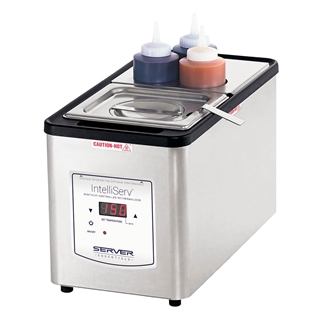Specifying Supplies | Heating up With Warmers
Written in partnership with Foodservice Equipment & Reports Magazine
How-To
2019.5.10
5 Steps to Choosing Warmers
As the weather warms up so do customers’ appetites for fresh, seasonal menu offerings. Countertop warmers offer support by holding sauces, soups and toppings at precise temperatures back-of-house. It may be a soup warmer to hold a creamy zucchini-and-coconut-milk soup or a specialty warmer to keep chocolate at the ready for dipped fruit. Follow these steps when selecting a warmer:
- Choose the right type and size.
Manufacturers offer 5 qt to 11 qt capacity soup warmers with single, double or triple insets. Specialty warmers for dips or syrups and topping warmers for pouches or squeeze bottles accommodate those needing smaller batches. Pick a warmer that’s too large and you won’t use its full capacity, taking up more valuable countertop space than necessary. Settle on a model that’s too small and it won’t keep up with the volume.
- Look for thermostatic control.
Select a warmer with a temperature-sensing thermostat versus a basic rheostat control. Units with a basic rheostat control only give low, medium or high or 1-10 settings. A temperature-sensing thermostat maintains a precise temperature even as product is depleted, which avoids scorching and product waste. Invest in a NSF-certified warmer for rethermalization (elevating product from refrigerated 40°F to a safe serving temperature of 165°F within two hours).
- Think through location.
Employees can move a countertop warmer around the kitchen as needed. Use it to hold sauces for pasta dishes at lunch, and then move it to the wait station to hold soups at dinner. Plan where staffers will use the warmer and make sure the countertop space and electrical outlet accommodate the unit.
- Lids matter.
At self-serve stations, consider soup warmers with hinged lids. A hinged lid keeps the countertop clean; a customer won’t set it down and create a mess. Also important, look for a lid with a lip that retains moisture. Once the customer closes the lid, moisture returns to the product, maintaining its flavor profile.
- Accessories count.
How will staffers plate product? Depending on the warmer, accessories may include food pans, lids, ladles, squeeze bottles and squeeze bottle insets. Heated spouts work well for nacho cheese.
Flexible countertop warmers easily adapt to menu changes throughout the day
by enabling employees to swap out insets as needed. This unit comes with
one warmer base that holds either one 1/3-size pan, two 1/6-size pans
or three 1/9-size pans. Or pair it with a squeeze bottle holder
to warm squeezable toppings for ice cream in the summer.
DOs and DON’TS: Warmer Care
• DO disassemble and clean the warmer before its first use and after use daily. Wash parts with dishwashing soap and hot water. Rinse them with clear water and then dry them with a clean cloth.
• DO sanitize parts that come in contact with food according to local code.
• On models with a heat plate, DON’T use abrasive brushes or pads as they could compromise the Teflon coating.
• DO remove limescale once a month or more as needed on models with water baths. Use a noncorrosive limescale remover to eliminate mineral buildup on the interior of the basin. Clean with soap and hot water.
• DON’T use any harsh chemicals to clean stainless. Avoid abrasive sponges or scrubber pads too.